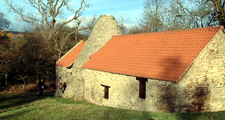Coalfield Valley
Land Management
Natural Features
- Fence river and stream banks against livestock to prevent erosion and allow natural regeneration of riverside vegetation.
- Protect ponds from drainage or infilling. Restore former ponds and create new ponds on suitable sites taking ecological advice.
- Create reed beds (using Common Reed or Great Reedmace) to condition mine water or sewerage discharges.
Farmland
- Maintain and enhance semi-improved pastures and meadows by adopting appropriate stocking levels or cutting regimes and avoiding improvements such as drainage, ploughing and reseeding. Limit the use of fertilisers and herbicides.
- Restore former meadows and restore diversity to improved pastures where possible by reseeding or the use of hay crops from local meadows as a seed source.
- Restore wet pasture and raised bog by blocking drains and raising water levels.
- Establish uncultivated margins along hedgerows, woodland edges and watercourses. Avoid cultivation under the canopy of hedgerow trees.
Trees, Woodlands and Forestry
- Conserve and extend dene and riverside woods.
- Restore replanted ancient woodlands by felling and natural regeneration, or restocking with native species of local origins.
- Increase the proportion of locally native species when restocking plantations.
- Plant new native oak or oak-birch woodlands along denes, valley floors and steep valley side bluffs, and alder woods along streamsides.
- Plant new small and medium sized mixed or broadleaved woodlands and particularly on former opencast land and close to settlement edges.
- Protect and maintain existing hedgerow trees. Plant new field boundary trees (Ash, Sessile Oak, Common Oak), particularly on restored opencast land. Tag saplings to replace the maturing stock.
- Plant small woodlands and tree groups to screen larger modern farm buildings, sewerage works, substations etc.
Cultural Features
- Protect archaeological features including rigg and furrow from damaging activities such as cultivation, tree planting or poaching by stock.
- Protect and conserve industrial features such as old drifts, spoil heaps, coke ovens, waggonways, watermills and lime kilns. Avoid physical damage, removal or infilling. Consolidate important structures taking archaeological advice.
- Conserve and restore parklands, respecting designed elements and veteran trees.
- Conserve and maintain traditional field barns and farm buildings.
Field Boundaries
- Protect and maintain hedgerows and stone walls.
- Renovate overgrown and gappy hedges by laying or coppicing and gapping up.
- Allow trimmed hedges to grow higher and broader. Consider trimming every second or third year rather than annually.
- Reinstate hedges and walls where they have been replaced by fences, particularly in areas of older enclosure, along enclosure roads and lanes, and on reclaimed or restored opencast land.
Development
Agricultural Buildings
- Site new farm buildings close to existing buildings where possible, and reflect their scale, character and materials.
- Reduce the impact of larger modern buildings by careful selection of colour, breaking up mass and planting screening belts of native species.
Housing and Economic Development
- Maintain the separation of villages and the rural character of the countryside between them in planning for new development.
- Screen new development on settlement edges with substantial structure planting of native woodland. Avoid prominent sloping valley side sites for new development or incorporate substantial internal structure planting.
Energy, Telecommunications and Infrastructure
- Site communications masts on buildings in urban areas where possible – or close to existing buildings, tree groups or woodland edges in the open countryside. Avoid prominent skylines.
- Avoid ‘urban’ detailing and street lighting on country roads.
Minerals and Waste
- Avoid damage to sensitive natural landforms, mature landscape features and semi-natural habitats in selecting and operating mineral sites.
- Avoid breaching local skylines with extraction areas or storage mounds.
- Restore sites to semi-natural oak and oak-birch woodland, lowland heath, acid and neutral grassland and wetland habitats using natural regeneration where appropriate.
- Adopt low intervention approaches to the reclamation of former colliery and industrial land where possible to preserve the landscape’s industrial heritage and ‘brownfield’ biodiversity.
Tourism and Recreation
- Tourism and recreational development should be undertaken in such a way as to avoid any urbanising influence on the landscape.
- Facilities like chalets and caravan parks should only be developed or extended where there is a high degree of year-round visual containment – either from the topography or robust woodland cover – so that they do not erode the rural character of the area.
- Golf course development should seek to conserve and reinforce landscape character by retaining mature landscape features and planting new native woodlands and parkland trees. Avoid prominent locations for built elements like buildings, driving ranges and ball-trap fencing. Develop species rich grassland or lowland heath in roughs to increase biodiversity.
- Equestrian facilities should be sited close to existing farm buildings where possible, and reflect their scale, character and materials. The impact of larger buildings should be reduced by careful selection of colour, breaking up mass, and planting screening belts of native woodland.
Further Information
- Description of Coalfield Valley Landscape Character
- West Durham Coalfield Strategy



